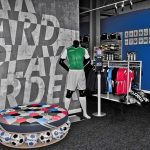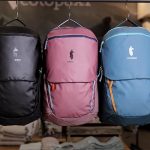Under Armour reported sales and earnings in the fiscal second quarter ended September 30 topped analyst targets on better-than-expected margins, but sales guidance was reduced due to further deterioration in the North American wholesale business.
“Several pressures impacting our North American business have persisted longer and are tougher since our last call,” said CFO Dave Bergman on the company’s second-quarter conference call with analysts. “The macroeconomic environment remains uncertain with continued inflation, mixed consumer confidence, and the effects of wholesale channel de-stocking having led to softness in our future order books. And while we’re not seeing significant cancellations, we don’t anticipate as many at-once or automatic replenishment orders as initially planned, so we’ve revised our full-year outlook expectations.”
Revenues for its fiscal year ended March 31 are now expected to be down 2 percent to 4 percent versus its prior outlook of flat to up slightly. By region, North America revenue is projected to be down 5 percent to 7 percent versus the previous expectation of down 3 percent to 4 percent. International revenues are expected to continue to be up at a low double-digit rate.
Companywide sales are expected to decline at a mid-single-digit rate in its current holiday quarter due to softer wholesale orders in North America, partially offset by continued DTC (direct-to-consumer) growth. For its fiscal fourth quarter ending March, sales are expected to be down about 3 percent to 5 percent versus the prior year.
Under Armour joined Levi Straus, VF Corp., Columbia Sportswear and others in citing weak North American wholesale orders in quarterly reports following the inventory build-up over the past year. On Wednesday, both Adidas and Ralph Lauren cited weakness in the North American wholesale channel in reporting second-quarter results.
“When we look towards the balance of the year, we expect a further contraction in North America, mainly due to ongoing pressures in our wholesale business, which have gotten tougher since our last call,” commented Stephanie Linnartz, who took over as Under Armour’s CEO in late February, on the call. “Several forces are at play here, including inflation and consumer confidence, normalizing inventory levels amid still broad promotions, and overall softness in our future wholesale order book. As a result, we lowered our fiscal ‘24 revenue outlook to reflect these challenges.”
On the positive side, margins in the quarter came in above plan in the quarter largely due to lower freight costs, enabling the company to raise its gross margin target and maintain its earnings guidance for the year.
Gross margin is expected to be up 100 to 125 basis points versus the previous expectation of up 25 to 75 basis points. SG&A expenses are expected to be “flat to down slightly” versus the previous expectation of “flat to up slightly”;
Operating income expectations remain unchanged from the previous expectation of $310 million to $330 million. EPS guidance also stays unchanged from the previous expectation of between 47 cents and 51 cents.
Linnartz also detailed progress Under Armour believes it’s making on its PTH3 (Protect This House Three) strategy announced in May, including better establishing the brand at “more premium retail” in the U.S. This includes its goal to increase the brand’s penetration inside malls, whether at athletic specialty or department stores. Leveraging the strength of key footwear franchises, including the Curry brand, Linnartz said Under Armour’s mall penetration is expected to be up more than 40 percent by the end of FY24. She said, “This is an early win, and I’m confident that as we drive brand heat and deliver better products, we will continue to gain premium shelf space.”
Second-Quarter Sales Flat
In the fiscal second quarter, sales were even year-over-year at $1.57 billion, exceeding analysts’ consensus estimate by $600,000 and in line with the company’s outlook. On a currency-neutral basis, sales were down 1 percent.
On a regional basis, NA revenue declined 2 percent to $991 million, in line with expectations, Bergman said on the call. Wholesale was down at about the same rate due to challenges in the brand’s full-price business, partially offset by growth related to inventory management strategies, which included normalization of its off-price channel mix from low levels last year. DTC was down slightly.
International revenue increased 5 percent to $573 million, or up 3 percent currency-neutral. EMEA revenue was up 9 percent to $287 million, or 4 percent on a currency-neutral basis, driven by solid DTC growth related to new store openings and strong underlying comps. EMEA wholesale was also up during the quarter.
APAC revenue was up 3 percent to $232 million, or ahead 7 percent on a currency-neutral basis. Growth was seen in both DTC and wholesale with China as a “leading contributor” to gains. Latin America revenues were down 8 percent to $54 million in the quarter, or down 19 percent on a currency-neutral basis due to the timing of distributor orders.
From a channel perspective, wholesale revenue was down 1 percent to $940 million, with decreases in the brand’s distributor business partially offset by higher sales to the off-price channel. The full-price business was flat. DTC revenue increased 3 percent to $596 million, due to a 4 percent increase in store revenue and a 2 percent e-commerce gain. Licensing revenue decreased 14 percent in the quarter to $29 million, driven by declines at North American and Japanese licensee partners.
By product type, apparel revenue was up 3 percent to $1.1 billion, driven primarily by growth in train and golf. Following several quarters of solid growth, footwear was down 7 percent to $351 million, driven primarily by softness in team sports and run. Within team sports, strong growth was seen in basketball.
Bergman noted that the year-ago fiscal second quarter benefited from a significant amount of footwear products that were previously delayed due to COVID-related factory constraints arrived at wholesale. For the second half of FY24, footwear sales are expected to be relatively flat against year-ago growth of 26 percent. Accessory sales in the second quarter were up 3 percent to $114 million.
Income Statement
Gross margin increased 260 basis points to 48.0 percent, driven by 410 basis points of supply chain benefits mainly due to lower freight costs. These benefits were partially offset by 120 basis points of unfavorable pricing due to deeper discounts in its sales to the off-price channel and the brand’s proactive strategy to reduce inventory through factory stores. UA also saw about a 20-basis points impact from of unfavorable channel mix related to a higher percentage of off-price sales
SG&A expenses increased 2 percent to $606 million due to higher marketing costs and increased slightly as a percent of sales to 38.7 percent from 37.8 percent Operating Income was $146 million, up 22.1 percent from $119.4 million a year ago.
Net income was $110 million, or 24 cents a share, up 26.4 percent against reported income of $87 million, or 19 cents a year. Earnings were up 19.6 percent from adjusted income of $92 million, or 20 cents, a year ago.
Inventory was up 6 percent to $1.1 billion. Inventory levels were in line with plans and are still expected to be down over the next two quarters to end FY24 down at a mid to high-teen percentage rate. Bergman said, “As our levels normalize, we feel very good about the quality and composition of the inventory we have on hand.”
PTH3 Improvement Plan Update
Linnartz discussed steps she’s embarked on since joining Under Armour to position the brand for profitable growth, including bringing in new talent. Among the new hires, she called out the appointment of Jim Dausch, who formerly worked alongside her at Marriott International, as chief consumer officer. She said Dausch has been visiting with wholesale partners in North America and EMEA to see “where opportunities exist for us to show up even better for our athletes and wholesale partners,” while advancing the brand’s consumer-facing approach online and optimizing marketing spend.
Linnartz also highlighted the addition of Shawn Curran, a 30-year Gap veteran, as chief supply chain officer.
Discussing progress under its PTH 3 plan, Linnartz said the first priority is “driving brand heat,” citing several examples of the brand better leveraging into the successes of Under Armour athletes, including Kelsey Plum of the recent WNBA champions Las Vegas Aces; the strong MLB campaigns this past year of Bryce Harper of the Philadelphia Phillies and Gunnar Henderson and Ryan Mountcastle of the Baltimore Orioles; and Sharon Ledecky’s third-place finish in last week’s New York City Marathon.
She also cited strong activations coming from campaigns featuring NFL wide receiver, Justin Jefferson; Notre Dame’s football coach Marcus Freeman and star quarterback Sam Hartman; and the brand’s first outdoor placements in London, Madrid and Barcelona to celebrate the start of the European Global Football season.
Linnartz said the brand’s marketing approach has become “much more focused on capitalizing on our assets to generate returns via product marketing rather than simply leaning into large-scale anthemic campaigns.” Activations also emphasize a strong link to social media. Linnartz said, “We want to be where that 16- to 24-year-old team sport varsity athlete is located. So, we’re seeing great progress on likes and shares and engagement.”
Execution on the second priority of the PTH3 plan, delivering elevated design and products, emphasizing footwear, sports style, and women’s businesses, was marked in the quarter by the hiring of John Varvatos as chief design officer. Varvatos, who has designed for Converse, Ralph Lauren and Calvin Klein and also found success with his eponymous label, “has quickly added leadership maturity, direction, and strength to our design organization, bringing a fresh perspective and helping us elevate our approach to our athletes’ lives outside the gym,” said Linnartz.
She added, “With the search for a new head of product underway, a new head of design, and using sneaker and branding experts to add horsepower to the team, it’s about getting the right talent in the right place to maximize our innovation and marketing engines to break through at the intersection of our style and design meet performance.”
She said footwear remains Under Armour’s “single most significant growth opportunity.” She noted that the brand is seeking ways to make the required investments to evolve its footwear approach while staying committed to near-term profitability goals. She said, “We are assessing the productivity of SKUs, styles, categories, sports marketing assets, and distribution channels to determine the most optimal path forward.”
Launch highlights include the Curry 11 Future Curry supported by the Curry brand’s first signing of an NBA athlete, De’Aaron Fox. Other drops included UA’s Slip Speed Youth style as an exclusive at Dick’s and UA’s direct channels. Coming launches include a Curry/Bruce Lee collaboration and the Slip Speed running shoe in February. Linnartz promised, “More drops, more energy, and, of course, more versatility to come.”
In sports style and women’s areas, Linnartz called out the Unstoppable Fleece collection, Meridian Cold Weather leggings and Forge 96 shoes. Linnartz said, “It’s all about premium executions of fit, fabric, and finish infused with the swagger and style our athletes desire.”
Linnartz added that while it will take time to overhaul the brand’s design approach, existing products are being re-merchandised and the brand is “selectively infusing limited run releases and capsules with an expectation that greater critical mass will arrive towards the end of next year.”
Finally, progress on its third priority, driving U.S. sales, was marked by the success in securing shelf space at mall-based chains and the launch of UA Rewards, its U.S. loyalty program, to a better-than-expected reception. Linnartz said, “Having surpassed 1 million members in our first few months, we see more robust engagement amongst our members. So far, UA Rewards members are almost twice as likely to make a repeat purchase and return to the brand within 90 days. So early points on the board in building greater brand love and loyalty.”
Touching on investments in the international business, Linnartz noted that Under Armour just opened its fourth London Brand House on Oxford Street, “marking an exciting milestone as we expand our presence in the U.K. and drive greater brand affinity across this important market.” In the APAC region, the local loyalty program has 7.5 million members and a franchise partner implementation is being piloted.
Linnartz concluded, “In summary, at the halfway mark of fiscal ‘24, we are progressing against our PTH 3 priorities. Acknowledging that this is a multi-year journey with much work ahead of us, most immediately we are focused on operational efficiencies and controlling costs to ensure we remain responsible stewards of the business. With our continued strategic evolution and a renewed mindset, I’m confident that we are building a stronger Under Armour with brand heat, more premium product offerings to inspire athletes worldwide, and ultimately a more robust profitable growth story in the long-term.”
Photo courtesy Under Armour
















